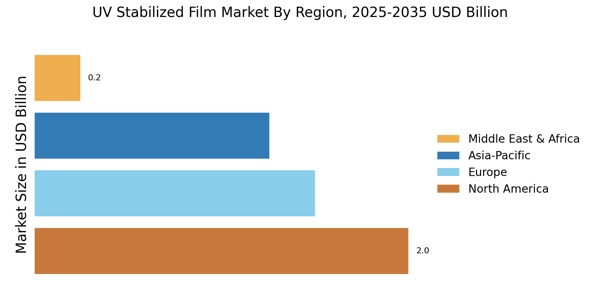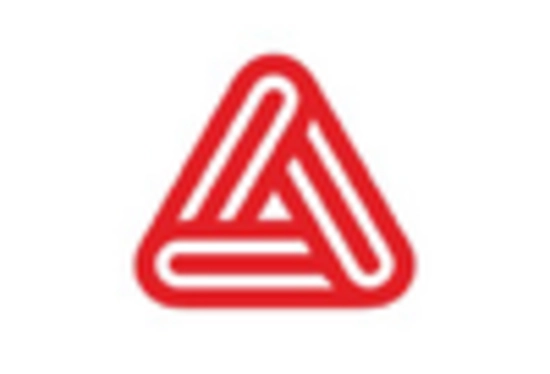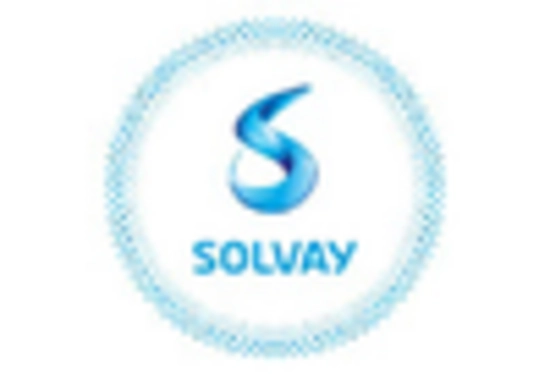Increased Awareness of UV Protection
Consumer awareness regarding the detrimental effects of UV radiation is on the rise, significantly impacting the UV Stabilized Film Market. As individuals become more informed about skin cancer and other health risks associated with UV exposure, the demand for protective solutions is expected to grow. This heightened awareness is driving the adoption of UV stabilized films in various applications, including automotive, agriculture, and outdoor furnishings. Market data suggests that the automotive sector alone is anticipated to witness a growth rate of around 4% annually, as manufacturers increasingly incorporate UV protection features into their products. This trend indicates a broader shift towards prioritizing health and safety, thereby bolstering the market for UV stabilized films.
Rising Demand in Construction Sector
The UV Stabilized Film Market is experiencing a notable surge in demand, particularly within the construction sector. As urbanization accelerates, the need for durable and protective materials has become paramount. UV stabilized films are increasingly utilized in building facades, skylights, and greenhouses, providing essential protection against harmful ultraviolet rays. This trend is supported by data indicating that the construction industry is projected to grow at a compound annual growth rate of approximately 5.5% over the next five years. Consequently, the integration of UV stabilized films in construction applications is likely to enhance their market presence, as builders seek materials that offer longevity and energy efficiency.
Sustainability Trends in Material Selection
The growing emphasis on sustainability is significantly influencing the UV Stabilized Film Market. As industries strive to reduce their environmental footprint, the demand for eco-friendly materials is increasing. UV stabilized films, particularly those made from recyclable or biodegradable materials, are gaining traction among environmentally conscious consumers and businesses. This trend is evident in sectors such as packaging, where companies are actively seeking sustainable alternatives to traditional materials. Market analysis indicates that the sustainable packaging segment is projected to grow at a rate of 7% per year, further driving the adoption of UV stabilized films. This shift towards sustainability not only enhances brand reputation but also aligns with regulatory pressures for greener practices.
Technological Innovations in Film Production
Technological advancements in the production of UV stabilized films are playing a crucial role in shaping the UV Stabilized Film Market. Innovations such as enhanced polymer formulations and advanced coating techniques are leading to the development of films with superior UV resistance and durability. These advancements not only improve the performance of the films but also expand their applicability across various sectors, including packaging, agriculture, and construction. Recent data indicates that the market for advanced polymer films is expected to grow by approximately 6% annually, reflecting the increasing demand for high-performance materials. As manufacturers continue to invest in research and development, the UV stabilized film market is likely to benefit from a continuous influx of innovative products.
Regulatory Support for UV Protection Standards
Regulatory frameworks promoting UV protection are emerging as a significant driver for the UV Stabilized Film Market. Governments and regulatory bodies are increasingly recognizing the importance of UV protection in various applications, leading to the establishment of standards and guidelines. These regulations are particularly relevant in sectors such as construction and automotive, where compliance with UV protection standards is becoming mandatory. As a result, manufacturers are compelled to incorporate UV stabilized films into their products to meet these requirements. Data suggests that regions with stringent UV protection regulations are likely to see a higher adoption rate of UV stabilized films, thereby expanding the market. This regulatory support not only enhances consumer safety but also fosters innovation within the industry.


















Leave a Comment